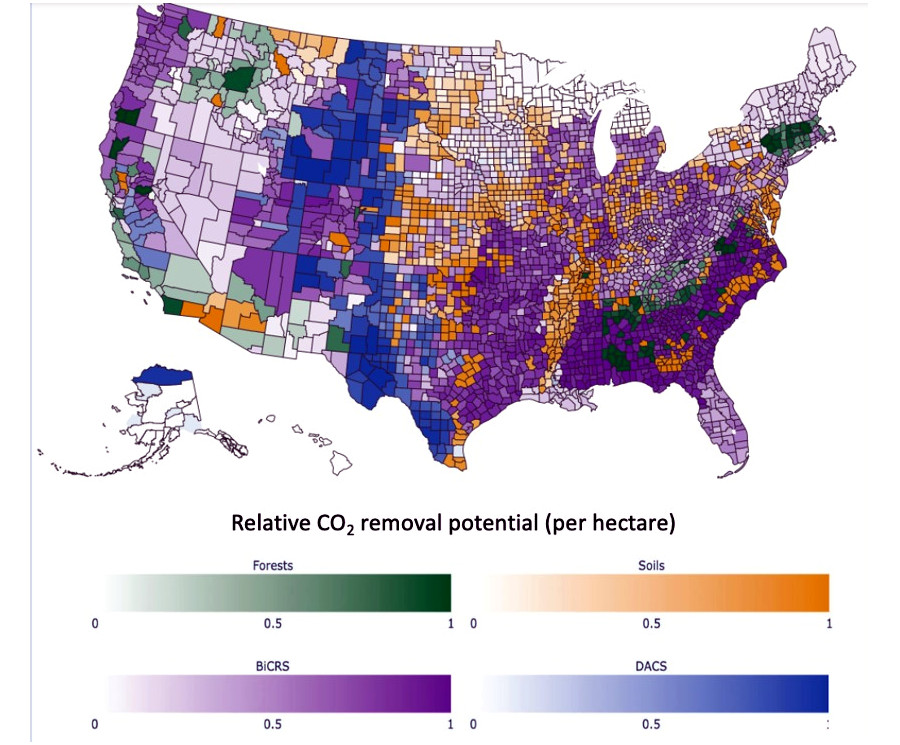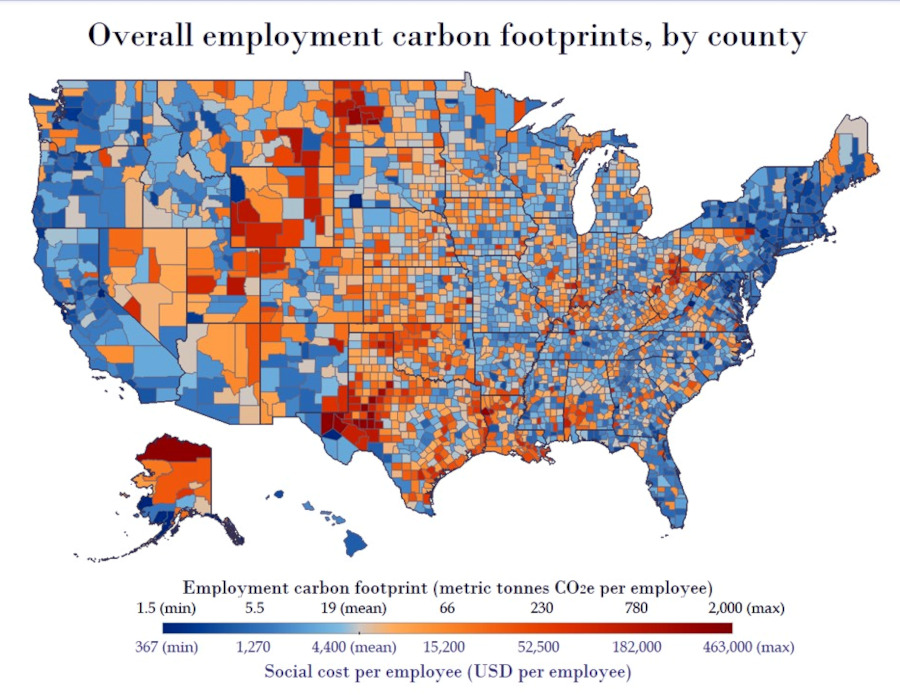Roads to Removal — a recent report co-authored by
scientists at Lawrence Livermore National Laboratory
and a dozen other institutions — features a detailed map that highlights
specific opportunities for carbon dioxide removal (CDR) in all 3,143 counties
across the US.
The map highlights, for each county, the CDR method — either forests,
soils, biomass, carbon capture and
storage,
or direct air
capture
— that can optimally leverage local resources and capabilities to remove
substantial CO2 and generate major socioeconomic benefits for local communities.
If all 3,143 counties implement CDR, the US can generate 440,000 long-term
jobs nationwide and achieve its goal of net-zero emissions by 2050.
 Options and opportunities for CDR in all 3,143 US counties. The options are
based on capacity and/or cost, weighted by the EEEJ (Energy Equity and
Environmental Justice) index and Center for Disease Control’s SVI (Social
Vulnerability Index) scores. | Source: Roads to
Removal
Options and opportunities for CDR in all 3,143 US counties. The options are
based on capacity and/or cost, weighted by the EEEJ (Energy Equity and
Environmental Justice) index and Center for Disease Control’s SVI (Social
Vulnerability Index) scores. | Source: Roads to
Removal
I fell in love with this insightful map because it is an ode to the US’s vast
diversity. Each county has a unique history, is uniquely affected by climate
change, and has unique local resources it can mobilize to decarbonize its local
economy and unleash unique local opportunities. This map shows that America is
the ‘Land of Climate Opportunities.’ If the US unlocks all these grassroots
opportunities, it can become a global climate leader.
I use this map in my new book, The Frugal Economy: A Guide to Building a
Better Way with
Less,
to show how we can empower all 3,143 US counties to fully benefit from their
equitable transition to a low-carbon economy.
2025: Shifting from national to local climate initiatives
2025 will mark the return of a climate skeptic as US President. Trump will
mostly likely withdraw the US from the Paris climate
agreement
for the second time, just as he did in
2017.
He will also weaken or roll back major federal laws and national
policies
including the Inflation Reduction Act
(IRA)
aimed at slashing emissions, building a clean energy-powered infrastructure, and
creating millions of green industrial jobs.
I, however, believe that behind every major crisis lies a historic opportunity.
For the United States as a nation, the return of Trump signals the end of the
‘Big Federal Government.’ But 2025 may also mark the rise of the Mighty Local
Government.
It is time for visionary State Governors and city mayors across the US to pick
up the leadership baton from federal institutions and launch bold initiatives to
fight climate change and create green jobs at the local level.
Here are my top two recommendations on how US policymakers at the state and
local level can join forces with academic, nonprofit, and private sector
partners and citizen groups to unleash and capture 3,143 climate opportunities
across America:
Implement hyperlocal, end-to-end value networks
Flush with funding from federal programs including the IRA and the CHIPS and Science
Act,
many states and counties are building green factories and investing in clean
energies like hydrogen. But beefing up “supply-side” capabilities is not enough
to shape new markets. You also need to enhance local demand to
“absorb” the
innovative, climate-friendly products and services developed locally.
As economist Amar Bhidé points out, the
US’s true strength is its “venturesome
consumption”
— that is, “the willingness and ability of businesses and consumers to
effectively use products and technologies derived from scientific research.”
Counties across the US should build end-to-end hyperlocal value
networks
that connect venturesome local buyers and innovative suppliers of climate
solutions.
In early 2023, carbon removal and utilization startups
CarbonCure
and Heirloom ran a successful pilot
project
that captured CO2 from the atmosphere and locked it permanently in concrete,
which was used in local construction projects. This entire value chain — the
carbon capture facility, the concrete batch plant and the construction sites —
was located within the San Francisco Bay Area. The partners intend to build
similar end-to-end value networks in other states, including Illinois and
Florida,
that will capture and utilize CO2 for local applications.
Likewise, Whisper Aero — a Crossville,
Tenn-based startup that builds super-quiet electric jets — launched
ReConnecTN, a
cross-sector coalition that aims to make the Volunteer State the pioneer in
sustainable Regional Air Mobility (RAM). The RAM market is poised to
reach $115 billion by
2035.
The EFI Foundation’s Hydrogen Demand
Initiative (H2DI) aims to shape demand-side hydrogen
markets across the US. H2DI will mobilize private investments to de-risk and
speed up the deployment of clean hydrogen produced by the seven Regional Clean
Hydrogen Hubs
(H2Hubs) across the
US. By proactively securing demand for clean hydrogen in energy-intensive
industry and heavy-duty transportation in multiple regions, H2DI seeks to
maximize the economic impact of H2Hubs — which has received $7 billion in
funding
from the US government.
Political and economic leaders at county, city or tribal level can consult the
Department of Energy’s interactive community benefits
map
that shows all the clean energy projects funded by the IRA and the Bipartisan
Infrastructure Law (BIL) that
are currently in demonstration or deployment phase across the US. Most of these
projects are focused on bolstering the supply side of a clean economy.
Informed by this map, local leaders can rapidly shape new markets and create
demand-side opportunities, as illustrated above, to absorb the innovative clean
energy technologies and skills being developed in their communities —
especially in rural
areas.
By building these hyperlocal, end-to-end value networks, counties across the US
can rapidly capture the full socio-economic value of projects funded by the IRA,
BIL, and CHIPS and Science Act.
Skill youth and retrain legacy workers
According to the non-profit Climate Power, the IRA has created over 334,000
clean energy jobs across the
US in two years. That seems impressive. Yet, a report by the Climate Jobs
National Resource Center shows that the IRA has the potential to generate
over 3.9 million well-paying jobs
related to clean energy. Unfortunately, filling these nearly 4 million job
openings will be an uphill task as almost all US states face a shortage of
qualified workers.
An analysis by the Political Economy Research Institute (UMass PERI)
at the University of Massachusetts-Amherst reveals that 20 occupations in
the US will face a total labor shortage of 1.1 million
workers
to fill new jobs created altogether by the IRA, BIL, and CHIPS and Science Act.
Several states are already feeling the pinch. For instance, Taiwanese
semiconductor manufacturer TSMC — which
received $11.6
billion
in CHIPS Act funding — has yet to start making chips in its Phoenix, Arizona
fabrication facility as it can’t find locally enough talented
personnel.
McKinsey estimates that the US chip manufacturing sector will face a
shortage of 146,000 skilled
workers by
2029.
How do we solve the skills shortage crisis in the US? The low-hanging fruit, and
the most humane thing to do, would to be to retrain and
upskill
the 1.7 million
workers
in fossil-fuel-based industries displaced by the energy transition. MIT
researchers have developed an interactive US
map
(another map I love!) that pinpoints the counties with high employment
vulnerability due to the energy transition.
 Overall Embodied Carbon Factors (ECFs) in metric tonnes of CO2e per employee at the county level across the US | Source: Assessing the distribution of
employment vulnerability to the energy transition using employment carbon
footprints (2024).
Overall Embodied Carbon Factors (ECFs) in metric tonnes of CO2e per employee at the county level across the US | Source: Assessing the distribution of
employment vulnerability to the energy transition using employment carbon
footprints (2024).
State policymakers can use this analytical data to prioritize worker retraining
and upskilling investments
in the most climate-vulnerable counties — thus, enabling equitable transition
across the US.
Furthermore, we need to educate (no pun intended!) the youth that they don’t
need a PhD, a master’s degree, or even a bachelor’s degree to get a job in the
clean energy and green manufacturing
sector.
A UMass PERI study shows that nearly 70 percent of the
jobs
created by the IRA, BIL and CHIPS Act are available to workers without a
bachelor’s degree — compared to the 59 percent jobs in the entire US workforce.
Practical, on-the-job training through apprenticeship programs, where you “earn
while you
learn,”
are the best way to onboard our youth into the clean economy. States can follow
the lead of Minnesota, where Governor Tim Walz catalyzed a $3 million
investment to boost
apprenticeship opportunities and train workers in clean technologies.
Political leaders at the state and local level must take a long-term view and
realize that the clean economy is not just another economy, but the economy
of the 21st century. As such, we need to anticipate future jobs in the clean
economy in every sector and proactively train US workers on skills in demand in
decades to come — as Brazil has just done by using its Labor Market
Foresight
Model.
In the same spirit, Fortifying America’s Future: Pathways for
Competitiveness
— a paper co-produced by the Federation of American Scientists and Aspen
Strategy Group —
offers sound strategies to develop career pathways from K-12 into high-demand
clean-economy industries to boost US competitiveness in a rapidly evolving
global marketplace. Individual states and cities across the US can use these
strategies as a baseline and adapt them to fit their local needs and resources.
The 3,143 US counties — and their leaders — should reframe the climate crisis as
a generational opportunity to build a durable future. By forging hyperlocal
value networks and proactively training their local workforce counties can
unleash 3,143 diverse climate opportunities across the country.
Get the latest insights, trends, and innovations to help position yourself at the forefront of sustainable business leadership—delivered straight to your inbox.
Navi Radjou is a French-American scholar and advisor on innovation and leadership.
Published Dec 16, 2024 8am EST / 5am PST / 1pm GMT / 2pm CET